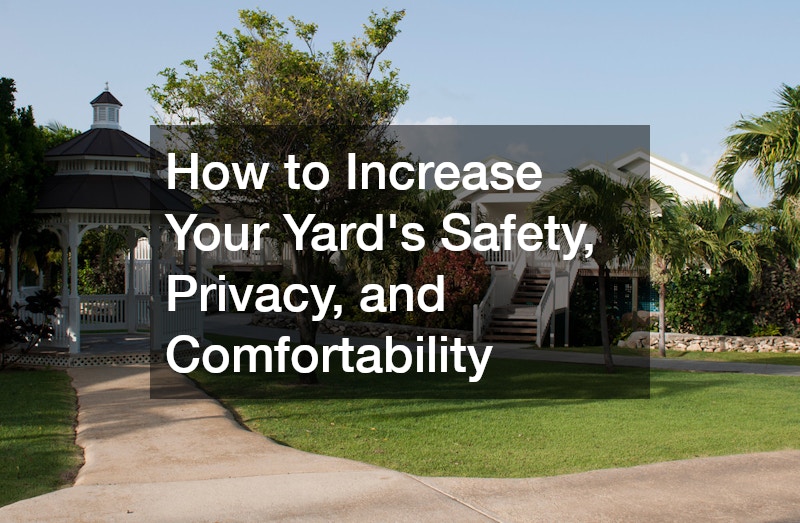
Transforming your outdoor space into a haven of safety, privacy, and comfort requires a thoughtful approach and a variety of strategies. Whether you want to shield your yard from prying eyes, ensure a secure environment, or create a cozy retreat, this comprehensive guide will provide you with actionable steps to achieve your goals. By implementing the following techniques, you can enhance your yard and make it a more enjoyable and secure part of your home.
1. How to Prevent Neighbor View with Landscaping

One effective way to enhance privacy in your yard is through thoughtful landscaping with the help of a landscaping company. Planting trees and shrubs is a time-tested method for obstructing the view from neighboring properties. Trees provide a natural barrier with their height and density, while shrubs can fill in gaps and create a lush, green screen. Consulting with tree services can help you select the right species that will thrive in your specific climate and soil conditions, ensuring that your privacy screen remains effective year-round. For a robust and long-lasting solution, consider species like arborvitae or holly, which grow densely and maintain their foliage throughout the year.
Using trellises and climbing plants is another strategic approach to enhancing privacy. Installing trellises in strategic locations and training climbing plants to grow on them can quickly create a vertical barrier that obscures views from outside. A landscaping company can assist in setting up these structures and recommending climbing plants such as ivy, wisteria, or clematis, which can provide both beauty and privacy. These trellises can also serve as attractive garden features, adding an element of design to your outdoor space while effectively blocking unwanted sightlines. By combining various types of plantings and structures, you can create a layered approach to privacy that is both functional and aesthetically pleasing.
Creating layered plantings can further enhance privacy while adding depth and texture to your landscape. Start with taller trees or shrubs at the back of your yard to provide a solid backdrop. In front of these, plant medium-sized shrubs and, finally, lower ground-cover plants. This tiered arrangement not only blocks views but also adds visual interest to your garden. Layered plantings help to create a natural barrier that feels more integrated with the landscape, offering a secluded retreat without the need for solid fences or walls.
2. Installing Fences and Screens
Installing fences and screens is a critical component in achieving a private and secure yard. Choosing the right fence material is fundamental to balancing aesthetics with functionality. Wood fences are a popular choice for their classic look and adaptability. They can be stained or painted to match your home’s exterior and can be customized in terms of height and design. However, wood fences require regular maintenance to prevent issues such as rot or warping. For a more modern alternative, vinyl fences offer durability and low maintenance. Vinyl does not need painting and is resistant to weathering, making it a long-term investment for privacy and security. Engaging with fencing services can help you determine the best material based on your needs, budget, and the style of your home.
The height and design of your fence are also crucial considerations. Taller fences generally provide better privacy, but you must ensure compliance with local zoning laws and HOA regulations regarding fence height. A well-designed fence can complement your home’s architectural style and enhance its curb appeal. When working with wood fence companies, you can explore various design options, such as lattice tops or decorative elements, which can offer added privacy while maintaining an attractive appearance. Additionally, considering different fence styles, such as solid board or semi-privacy, allows you to choose an option that best suits your privacy needs and aesthetic preferences.
Temporary and decorative screens can offer flexible and immediate solutions for privacy. These screens come in a variety of materials, including bamboo, fabric, and metal, and can be used to create private areas or block specific views. They are particularly useful for renters or those looking for a non-permanent solution. Installing these screens is typically straightforward, and they can be easily repositioned or removed as needed. Incorporating decorative screens into your landscaping adds an element of design while providing functional benefits. These screens can also be combined with other privacy solutions to create a multi-layered approach to yard privacy.
3. Setting Up Outdoor Lighting for Safety

Setting up outdoor lighting is essential for increasing the safety and security of your yard. Motion-sensor lights are a practical choice for deterring intruders and enhancing visibility during nighttime hours. These lights activate automatically when they detect movement, providing illumination that can alert you to any unusual activity and prevent potential break-ins. Motion-sensor lights are particularly effective when placed near entry points, walkways, and other vulnerable areas around your home. Installing them in strategic locations can significantly improve the security of your property while reducing the risk of accidents due to poor visibility.
Pathway and landscape lighting are also important elements in creating a safe and inviting outdoor space. Properly lit pathways help prevent trips and falls by ensuring that walkways are clearly visible after dark. Landscape lighting enhances the beauty of your garden and highlights features such as plants, statues, or water features. By installing lighting along paths and in key areas of your garden, you create a welcoming environment that can be enjoyed at any time of day or night. In addition to improving safety, well-placed lighting contributes to the overall ambiance and usability of your outdoor space.
Detering intruders with lighting involves using a combination of bright, motion-activated lights and softer, ambient lighting to create a well-lit and secure environment. Bright lights can dissuade potential intruders by eliminating shadowy areas where they might otherwise conceal themselves. At the same time, ambient lighting adds a layer of comfort and usability to your yard, making it more enjoyable for evening activities. By integrating both types of lighting, you create a balanced approach that enhances safety while maintaining a pleasant atmosphere for outdoor enjoyment.
4. Creating Comfortable Seating Areas
Comfortable seating areas are essential for enjoying your outdoor space. When selecting outdoor furniture, choose durable materials that can withstand the elements. High-quality options such as teak, eucalyptus, or powder-coated metal are excellent choices for longevity and resilience. Adding cushions and throws can enhance comfort and create a cozy atmosphere. These accessories not only provide extra padding but also allow you to introduce color and texture to your seating area. Arranging furniture to promote conversation and relaxation is another key consideration. Create distinct areas for different activities, such as dining, lounging, and entertaining, to maximize the usability and comfort of your outdoor space.
5. Utilizing Outdoor Structures for Privacy

Incorporating outdoor structures can significantly enhance privacy and comfort in your yard. Pergolas and gazebos provide sheltered spaces where you can relax and entertain while maintaining a degree of seclusion. These structures can be adorned with curtains or climbing plants to further increase privacy and create a more intimate setting. Additionally, creating private outdoor rooms, such as a secluded reading nook or a meditation space, can provide a retreat within your yard. Strategically placing screens and walls, such as patio enclosures, can offer an additional layer of privacy and protection from the elements. These structures help to delineate different areas within your yard and provide a sense of enclosure.
6. How to Safeguard Against Pests and Wildlife
Safeguarding your yard against pests and wildlife is crucial for maintaining a comfortable and enjoyable outdoor environment. Fencing and netting solutions can be effective in keeping unwanted animals at bay. Installing barriers around garden beds or using netting over plants can protect your landscaping from common pests. Engaging a local exterminator can help address specific pest issues and provide tailored solutions for your yard. Using natural repellents is another eco-friendly method for keeping pests away. Many plants, such as lavender or mint, have natural deterrent properties that can help keep insects at a distance. Additionally, creating a wildlife-free zone by removing food sources and nesting areas can further minimize the attraction of unwanted animals.
7. Effective Use of Mulching and Ground Covers

Mulching and ground covers are practical solutions for enhancing both privacy and aesthetics in your yard. Various types of mulch, such as wood chips, bark, or gravel, can be used to cover soil and create a clean, finished look. Mulch also helps to retain moisture, suppress weeds, and regulate soil temperature. Maintaining ground cover is important for ensuring that it remains effective and visually appealing. Regularly check for weeds and replenish mulch as needed to keep your yard looking its best. Hydroseeding services can also be utilized to establish ground cover quickly and efficiently. Ground covers such as creeping thyme or clover can add a lush, green layer that enhances privacy and contributes to the overall beauty of your landscape.
8. Incorporating Water Features for Sound Privacy
Water features can add both aesthetic appeal and functional benefits to your yard. Installing fountains and waterfalls with the help of hardscape contractors creates soothing sounds that can help mask unwanted noise and increase privacy. These features can be designed to complement your landscaping and provide a calming atmosphere. Proper maintenance of water features is essential to ensure their longevity and performance. Regular cleaning and checking for any issues will keep your water features in optimal condition. Combining water features with landscaping elements, such as rocks or plants, can enhance their visual impact and integrate them seamlessly into your outdoor space.
9. Child and Pet Safety Measures
Ensuring the safety of children and pets in your yard is a top priority for any homeowner. Building safe play areas for children involves using soft ground coverings like rubber mulch or grass to minimize injury from falls. Secure yard boundaries are crucial for keeping pets and kids contained within a safe area. Installing a secure fence or gate can prevent them from wandering off and protect them from potential hazards. Additionally, choosing non-toxic plants and materials is essential for avoiding health risks. Opt for pet-friendly and child-safe plants, and ensure that any chemicals or fertilizers used in your yard are safe for both children and animals.
10. Adding Shade and Weather Protection
Incorporating shade and weather protection into your yard enhances comfort and usability. Various options for shade structures, such as pergolas, awnings, and umbrellas, provide relief from the sun and make outdoor spaces more enjoyable. Awning installers can help you select and install the right type of shade structure that complements your yard’s design and meets your needs. Choosing weather-resistant furniture is also important for ensuring that your seating and dining areas withstand the elements. Look for materials that are designed to resist moisture, sun exposure, and temperature fluctuations. Additionally, protecting against sun and rain involves using covers or canopies to shield your outdoor spaces, allowing you to enjoy your yard in various weather conditions.
Conclusion
Enhancing your yard’s safety, privacy, and comfortability requires a multifaceted approach that considers various elements of your outdoor space. By implementing effective landscaping strategies, installing appropriate fences and screens, and setting up outdoor lighting, you can create a safer and more private environment. Comfortable seating areas and outdoor structures, such as pergolas and gazebos, add to the enjoyment and functionality of your yard. Addressing pest control with pest control services, using ground covers, and incorporating water features further contribute to the overall comfort and privacy of your space. Finally, ensuring child and pet safety and adding shade and weather protection will help you maximize the usability and enjoyment of your outdoor area. Thoughtful planning and execution of these strategies will transform your yard into a secure and pleasant sanctuary, allowing you to fully enjoy your outdoor living experience.





